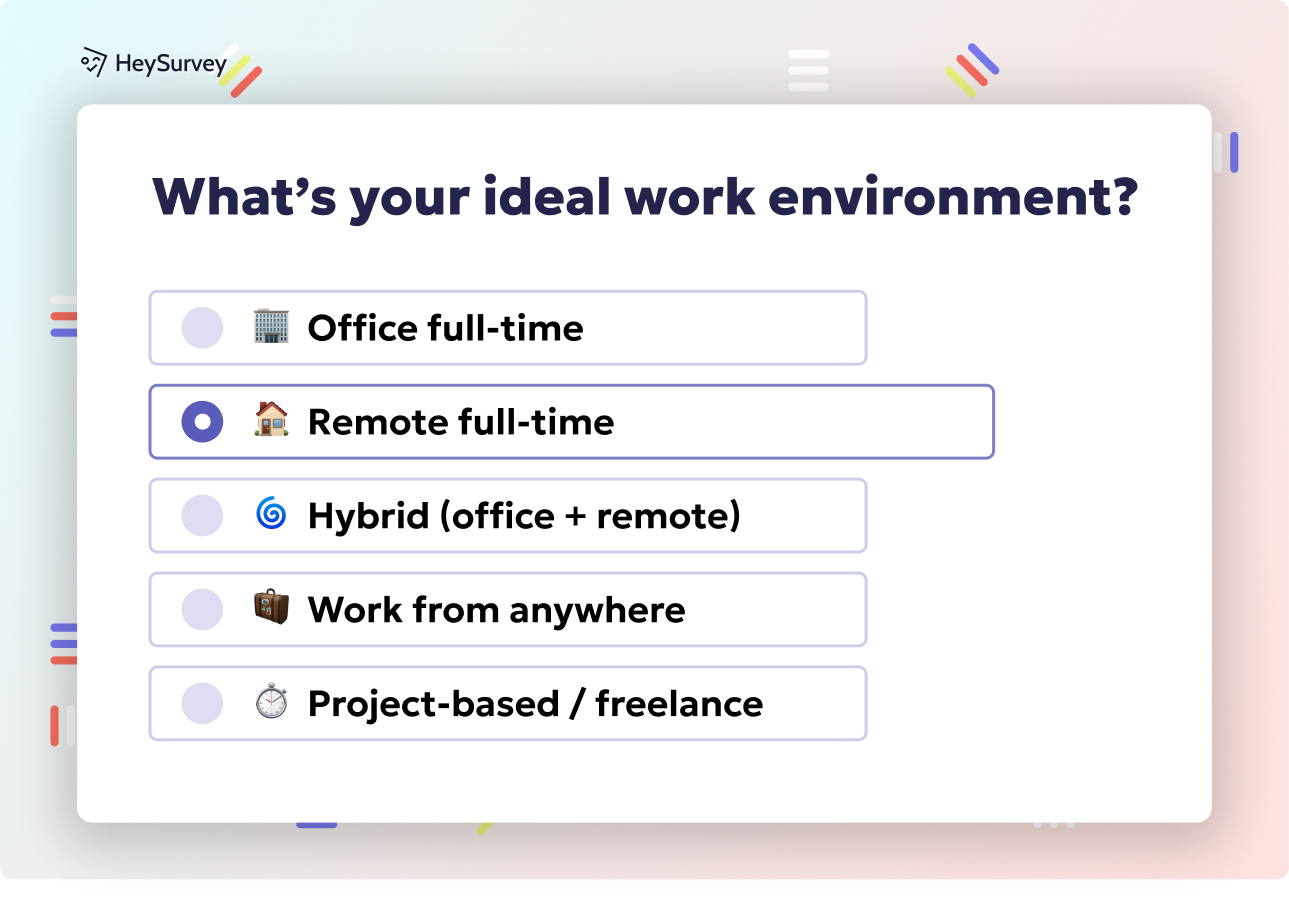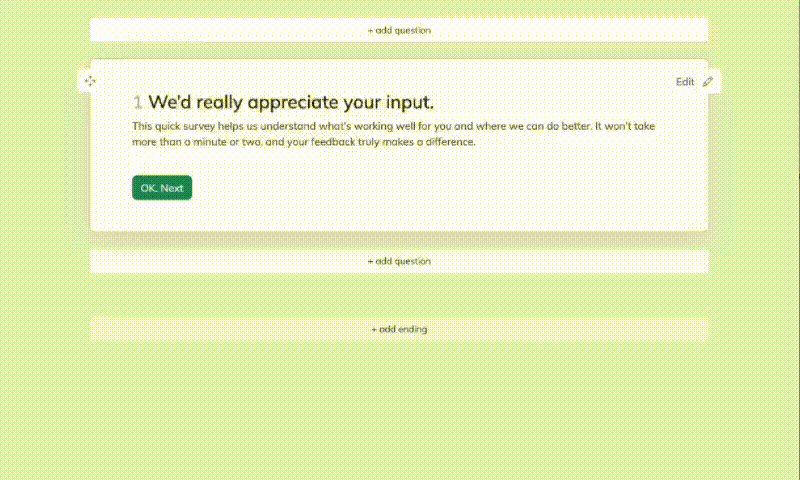31 Exit Interview Survey Questions for Students to Boost Insights
Discover 25+ exit interview survey questions for students to improve retention, program quality, career readiness, and alumni engagement.
Alumni aren’t born in a vacuum—they graduate, withdraw, or simply move on from campus. That’s when student exit interview surveys (also called a "college exit survey" or "graduation feedback form") jump into action. These tailored surveys capture those final, honest thoughts to help boost retention, polish programs, and strengthen alumni ties. Whether at universities, community colleges, or online programs, timely surveys—sent just before graduation or after withdrawal—give schools a last shot at learning what makes students tick (or quit), and why it matters.
Academic Experience Survey
Why & When to Use This Type
Collecting academic experience feedback is like holding up a mirror to your coursework, faculty, and support systems. Schools use this survey to spot what’s working, where students struggle, and which bits of the curriculum really shine. The key moment to ask? Right before graduation or soon after withdrawal—when students’ memories are fresh, and their advice is unfiltered.
Using these surveys helps institutions to:
- Uncover gaps or redundancies in the curriculum
- Evaluate the effectiveness of instructional materials and technology
- Gauge workload balance for student well-being
- Measure whether teaching methods actually drive understanding
- Highlight standout (or underperforming) courses and faculty
With this intelligence, programs can upgrade, adapt, and keep future students engaged instead of overwhelmed. Plus, letting students review their academic journey makes them feel heard—just before flipping their tassels or waving goodbye.
Sample Questions
Here are five sample questions that offer both depth and direction for academic surveys:
How effectively did course content align with your learning goals?
Which courses most enhanced your critical-thinking skills, and why?
Were instructional materials (texts, LMS resources) accessible and up to date?
Rate the overall teaching quality in your major on a 1–5 scale.
What academic challenges most impacted your performance?
By blending ratings, open-ended queries, and direct improvement asks, these questions get to the heart of academic strengths and pain points.
Implementing structured exit interviews with targeted questions enables institutions to identify curriculum gaps, assess teaching effectiveness, and enhance student support services. (smartsurvey.co.uk)

Creating your student exit interview survey with HeySurvey is easy—and fun! Here are 3 simple steps to get you going quickly, plus some handy bonus tips to make your survey stand out.
Step 1: Create a New Survey
- Head to HeySurvey and click “Create New Survey” to get started.
- Choose to start with an empty survey if you want total control, or pick a pre-built template to save time.
- Give your survey an internal name so you can find it later easily.
This sets the stage and gets your survey canvas ready for your questions.
Step 2: Add Questions
- Click the Add Question button to start building out your survey.
- Pick question types that fit your needs: text, multiple choice, Likert scale, or rating scales are great for exit interviews.
- Enter your question text, add descriptions if helpful, and mark questions as required where necessary.
- Use branching if you want follow-up questions based on specific answers (like asking more about academic challenges if a student rates teaching poorly).
You can mix open-ended and rating questions to capture both numbers and stories.
Step 3: Publish Survey
- Click Preview to see how your survey looks on different devices—phones, tablets, and desktops all supported.
- When everything looks great, hit Publish to generate a shareable link.
- Share this link via email, your student portal, or embed it in a website.
Publishing requires a free account, but that also lets you collect and review responses easily.
Bonus Step 1: Apply Branding
- Add your school or program logo at the top left corner to give your survey an official feel.
- Customize colors, fonts, backgrounds, and question card designs via the Designer Sidebar for a polished experience.
- Consider using your institution’s brand colors for instant recognition.
Branded surveys boost trust and response rates!
Bonus Step 2: Define Settings
- Use the Settings Panel to schedule when your survey opens and closes—perfect for collecting feedback only at graduation time.
- Limit the number of responses if you want to control data size or timing.
- Set a redirect URL to thank students or guide them to alumni resources after completion.
- Enable or disable options like showing respondents some results or keeping responses anonymous.
These tweaks tailor your survey flow to your exact needs.
Bonus Step 3: Skip into Branches
- Want a dynamic survey that adjusts questions based on student answers? Use branching!
- Define which question should appear next depending on each response choice, for example:
- If a student says they didn’t use tutoring services, skip those questions.
- If safety concerns were reported, follow up with details to better understand.
- If a student says they didn’t use tutoring services, skip those questions.
- Branching keeps your survey relevant and respectful of respondents’ time.
Ready to launch your student exit interview survey? Click the template button below to open a ready-to-go draft in HeySurvey and start customizing today!
Campus Life & Engagement Survey
Why & When to Use This Type
A campus isn’t just classrooms. It’s late-night debates, club meetings, pick-up games, and lifelong friendships. Campus life and engagement surveys explore whether students felt welcome, safe, and energized—or disconnected and left out. These surveys aren’t just for residential students; they shine light on the experiences of commuters and online learners too, helping schools compare group engagement.
This survey matters because it digs into:
- The quality and inclusiveness of residence life
- The diversity and vibrancy of student organizations
- How well campus activities and events reflect varied student interests
- Perceptions of campus safety, day and night
- Suggestions for boosting the energy of student life
Timing is flexible. Run surveys at the end of a term, after move-out, or post-commencement. The goal: identify what makes students stick—and what sends them packing.
Sample Questions
A lively campus experience makes a difference. These sample questions open space for honesty and action:
How satisfied were you with residence hall living conditions?
Which student organizations most influenced your sense of belonging?
Did campus events accommodate diverse interests and schedules?
How safe did you feel on campus during day and night?
What one change would most improve student life here?
These questions invite students to share not just complaints, but the "little things" that made campus memorable or, well, forgettable. Responses reveal the heartbeat (or hiccups) of campus culture.
A Student Voice survey found that over 75% of students spending at least one hour weekly on extracurriculars are satisfied with their campus involvement. (insidehighered.com)
Career Preparation & Outcomes Survey
Why & When to Use This Type
Today’s students aren’t just after knowledge—they want to land jobs, internships, or graduate spots when the diploma drops. A career preparation and outcomes survey checks whether academic programs deliver practical, market-ready skills and connections. It’s gold for both external marketing and internal improvement.
Deploy this survey 4–6 months before graduation so students can talk about their prep, AND after, to see where they land. These insights let schools:
- Fine-tune career counseling and job placement efforts
- Prove return on investment to accreditors, donors, and skeptics
- Highlight success stories for recruitment materials
- Identify gaps in employer partnerships or networking
- Ensure all students have equal access to career resources
Both pre-graduation jitters and post-diploma realities shape how career readiness is perceived and achieved.
Sample Questions
Looking for honest perspectives about job prep? Try these focused questions:
How confident do you feel about entering the workforce with the skills gained?
Rate the usefulness of career coaching appointments.
Did you complete an internship, co-op, or practicum? Describe its impact.
Have you accepted a job offer or graduate-school admission? If yes, please specify.
What additional resources would enhance career readiness?
The answers can uncover if students are truly prepared or just hopeful. They also shape actionable ways to boost future grads’ success.
Support Services & Resources Survey
Why & When to Use This Type
Lost on campus? Behind in math? Struggling to pay the bills or just need someone to talk to? That’s where support services and resources step in. This survey measures the real-world value of advising, counseling, tutoring, and financial aid support—figuring out what worked and what didn’t.
For best results, issue the survey during final advising meetings or exit counseling. This ensures clarity and captures a student’s final thoughts before they unplug from campus systems. Institutions can use this data to:
- Identify overbooked or under-resourced services
- Find out if students actually know where to get help
- See what’s missing for at-risk or non-traditional learners
- Allocate resources where they’re most needed
- Deliver better student support with real impact
Surveys paint a full picture of who used what support—and whether it made any difference.
Sample Questions
When it comes to academic and personal resources, these questions get to the core:
Rate the availability of academic advising appointments.
How effectively did tutoring services help you succeed in challenging courses?
Were mental-health resources accessible when needed?
Did financial-aid staff clearly explain your aid package and repayment options?
Which support service had the most positive impact on your persistence?
The resulting answers help focus future investments, giving students well-timed, meaningful support every step of the way.
Effective exit interview surveys for students should include questions that assess the utilization, satisfaction, and impact of support services to identify areas for improvement. (poll-maker.com)
Diversity, Equity & Inclusion (DEI) Survey
Why & When to Use This Type
A true sense of belonging goes deeper than hashtags or posters. DEI exit surveys check if the campus feels genuinely inclusive, how differences are handled, and whether students experienced bias. They also help colleges meet accreditation and regulatory demands for diversity, equity, and inclusion.
To maximize honesty, administer the survey post-graduation—when students can be candid, knowing their feedback won’t impact grades or recommendations. The survey helps schools:
- Monitor whether all voices feel respected
- Track the success of inclusion and diversity training
- Uncover unseen bias or discrimination
- Guide new policies and training for staff and students
- Prioritize the most needed changes
The focus is less about “looking good” on paper, and more about making students truly feel at home.
Sample Questions
To unlock authentic DEI feedback, these are strong openers:
To what extent did you feel respected regardless of your identity/background?
Were diverse perspectives incorporated into course discussions?
Did you witness or experience discrimination? Please elaborate.
How satisfied were you with cultural competency training offered on campus?
What DEI initiatives should the institution prioritize?
Raw, real answers can surface blind spots and fuel substantive diversity improvements across campus life and academics.
Institutional Climate & Governance Feedback Survey
Why & When to Use This Type
Every campus has an identity shaped by leadership, communication style, and response to crisis. The institutional climate and governance survey collects student perceptions about transparency, trust, and effective management—topics often overlooked in day-to-day feedback.
Why wait until after final grades? Simple: reduce grade-related bias and ensure honest reflections. This survey offers invaluable feedback for:
- Evaluating how well leadership communicates with students
- Checking if policies are clear, fair, and well-publicized
- Reviewing crisis responses (think: pandemics, campus emergencies)
- Understanding overall student trust in administration
- Shaping the reputation future grads carry into the world
The feedback often delivers the biggest surprises—for better or worse. It tells campus leaders what’s really working and where ambiguities or tensions live.
Sample Questions
Ready to test institutional trust? These questions unlock student perceptions:
How transparent was institutional decision-making during your tenure?
Rate the clarity of communication regarding policy changes.
Did you trust campus leadership to act in students’ best interests?
How well did the institution respond to crises (e.g., pandemic, security incidents)?
Would you recommend this institution to prospective students? Why or why not?
Direct feedback on governance and climate can make a shaky reputation solid—or highlight when it’s time for a serious overhaul.
Transition & Alumni Relationship Survey
Why & When to Use This Type
Graduation isn’t the end; it’s another beginning. The transition and alumni relationship survey builds bridges from student life to active alumni engagement, keeping connections fresh while contact information is still current.
Surveying within two weeks of graduation ensures relevance. The survey helps colleges:
- Gauge interest in alumni networks, mentorship, and continuing education
- Identify which benefits and events excite future alumni
- Build a database for communications—without losing track of new grads
- Understand giving intentions and the roots of alumni loyalty
- Offer seamlessly tailored alumni programming
By asking soon—and updating contact details—institutions keep graduates invested and involved.
Sample Questions
Building active alumni isn’t luck. These questions set the stage:
How interested are you in joining the alumni association?
Which alumni benefits (networking events, career services, lifelong learning) appeal to you most?
Would you mentor current students in your field?
How likely are you to donate to the institution in the future?
Preferred communication channels for alumni news (email, LinkedIn, text)?
The answers illuminate what makes alumni stick around—and give back.
Best Practices: Dos and Don’ts for Student Exit Interview Surveys
A few simple “exit survey dos and don’ts” boost both response rates and insight quality. First, let’s shine a light on the must-haves:
Dos:
- Personalize surveys by program, so questions feel relevant
- Keep survey length under 15 minutes to avoid survey fatigue
- Mix quantitative (scales, ratings) and qualitative (short answer) items
- Ensure anonymity to encourage honesty and open criticism
- Share a summary of findings and highlight improvements to close the loop
On the flip side, beware the common traps dabbling survey designers fall into:
Don’ts:
- Overload questions with academic jargon that confuses respondents
- Ask leading questions or “steer” answers toward positive or negative
- Ignore mobile optimization—most students survey on their phones
- Delay survey distribution until memories fade or contacts go cold
- Forget incentives, whether a simple thank you or a small gift card
Focus on these best practices for student exit surveys to boost data quality and strengthen your improvements. The clearest, most actionable data comes from respectful design, quick timing, and a dash of student empathy.
Student exit interview surveys are the unsung heroes behind campus improvements, happy alumni, and smarter program decisions. Honest feedback—when captured with care—shapes services and reputation for years to come. From academic experience to alumni engagement, every question and every answer builds a better institution. Go ahead: ask, listen, and let students have the final word, even as they step into their next big adventure.
Related Exit Interview Surveys

31 Intern Exit Interview Survey Questions to Improve Programs
Discover 30 essential intern exit interview survey questions designed to capture valuable feedbac...

